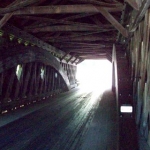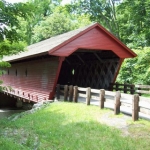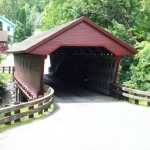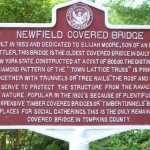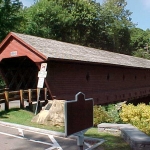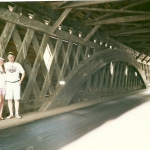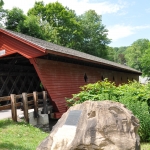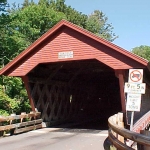NEWFIELD COVERED BRIDGE TOMPKINS COUNTY NY-55-01
Built in 1853 by Benjamin Starr and Samuel Hamm & Sons. A single span of 115′ crossing the West Branch of Cayuga Creek. Displays a Town truss with an added laminated arch. Rehabilitated in 1998. From NY 13 go into the town of Newfield. Bridge is located on Bridge St. GPS: N42° 21.768′ W076° 35.417′
NEWFIELD BRIDGE NY-55-01
Newfield bridge was originally built by Samuel Hamm & Sons, David Dassance, and Patchen Parsons in 1853, it is listed on the National Register of Historic Places effective February 25, 2000. It is the oldest surviving covered bridge still open to daily vehicular traffic.
Located in the Town of Newfield, east of State Route 13 in the Village of Newfield. It is over the west branch of the Cayuga Creek and a single span of 115 feet of Town truss. A Laminated arch was added in 1972 when Milton Graton re-built the bridge.
Directions to the bridge:
Follow the signs on State Route 13, either northbound OR southbound, as you approach Newfield. The bridge is in the center of the village and well marked.
“The Newfield Covered Bridge”
The Covered Bridge History (up to 1972)
Newfield’s covered bridge is the last survivor of the three original covered bridges erected in Tompkins County. This bridge spans the West Branch of Cayuga Inlet and occupies a log bridge site that we are told dates back from 1812, when the hamlet was called Florence. So far, it has been impossible to locate any definite information about the log bridge, as all the records of the town, excepting the 1811 Town minutes, were destroyed by fire in June, 1875. Then are notes stating that the first sawmill built in Newfield in 1809 by Eliakim Dean was just about where the Covered Bridge is now.
The Covered Bridge was erected during the years 1851-53, even though it has been told that it was first planned in 1848. At the time of construction, lumber was plentiful and labor was cheap. Men worked from sunup to sundown for $1.00 a day and lumber cost $6.00 per one thousand board feet. The total cost of the bridge was $800.00. The bridge is 115 feet long and 16 feet wide.
Stone masons, Benjamin Starr and Dick Russell laid the abutments for the bridge. The carpenters on the job were Samuel Hamm and his sons, David and Sylvester, also David Dassance and Patchen Parsons. Samuel Hamm died about 14 years after the bridge was built and is buried in Woodlawn Cemetery in Newfield. Several descendants of the men who built the Covered Bridge are still residents of Newfield today.
Daniel Tunis turned all the wooden pins, called trunnels (tree nails) with which to secure the Town Lattice Truss. The most popular covered bridge designs were called Burr Truss and the Town Lattice Truss. Many of the covered bridges still standing are, like the New-field bridge, the Town Lattice pattern which was patented in 1820 and 1835 by an architect of New Haven, Connecticut, Ithiel Town. By this method, planks are joined together with trunnels in a lattice pattern. This type truss is actually an uninterrupted series of crisscross diagonals and it has been said it could be built by the mile and cut off by the yard. This was an easy and less expensive way to build bridges and lighter timbers could be utilized, yet provide reliable and enduring strength.
When the Newfield bridge was built, solid siding originally ran the length of the bridge, but later diamond-shaped openings were cut through to admit light. This structure was dedicated to Elijah Moore, son of an early settler. It has been said that $200.00 was deposited in a bank to pay an artist to beautify the bridge with a mural, similar to the ones in the famous covered bridges in Luzern, Switzerland. However, the artist died, the committee failed to agree on his replacement and the onset of the Civil War ended the decorating plan.
Newfield, in its time, has survived many floods. One in particular, in June, 1905, swept away 4 or 5 dams above the Covered Bridge and washed tons of sand and gravel against the old bridge. It has been reported that there have been several small fires over the years in the bridge, but fortunately little damage was done at any time.
Tracing back through the life of the bridge, Newfield’ers recall that the community bustled with activity in its early days. There were two grist mills below the bridge, a sawmill, a tannery and a woolen mill above. Old timers tell us why bridges were originally covered. It was cheaper to roof the bridge every 20 years or so, than to build a new one. The roof protected the flooring and other parts of the structure from the elements.
The Newfield Covered Bridge is the oldest covered bridge in daily use in New York State and is one of the 25 authentic ones left from more than 250 the State once had. The last pair of oxen to be driven over the bridge were owned by Charles Fish, who later moved to Breesport. Mr. Fish and his oxen were a familiar sight in Newfield 50 years or more ago. The Newfield Covered Bridge has never been closed to traffic, except while repairs were being accomplished. Tompkins County’s lone survivor stands farther west in the State than any other of the authentic covered bridges now standing. The Newfield structure has undergone floor repairs and reshingling several times in its 119 years. Many covered bridges lost these day are due to neglect, some are victims of arson, malicious mischief and floods.
Complete restoration, including raising the entire bridge one foot, replacing trunnels throughout the bridge, strengthening and doing many other needed repairs have started and are being done by one of the few men who still build authentic wood n covered bridges, Mr. Milton S. Graton of Graton Associates, Ashland, New Hampshire.
Many photos show the “Musser Overlook” built in 1998 while the bridge went through another restoration. The overlook was named for Grant & Marie Musser, “Official Keepers of the Bridge” as designated by Tompkins County. The Musser’s were members of the New York State Covered Bridge Society and led a gallant effort to save the bridge from destruction or replacement. Their original efforts led to the 1972 restoration by Milton Graton. The Musser’s both passed away in 1999 just before the bridge was listed on the National Register of Historic Places.
From Newfield 150 Years (1822-1972)
Contributed by Florence Emery

